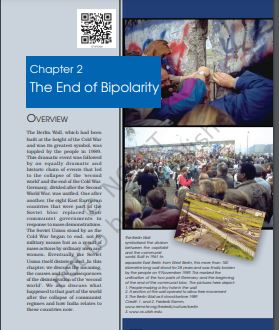‘NCERT Solutions for Class 12 Political Science Chapter 2‘ PDF Quick download link is given at the bottom of this article. You can see the PDF demo, size of the PDF, page numbers, and direct download Free PDF of ‘Ncert Class 12 Political Science Chapter 2 Exercise Solution’ using the download button.
NCERT Class 12 Political Science Textbook Chapter 2 With Answer PDF Free Download

Chapter 2: The End of Bipolarity
The Berlin Wall, which had been built at the height of the Cold War and was its greatest symbol, was toppled by the people in 1989.
This dramatic event was followed by an equally dramatic and historic chain of events that led to the collapse of the ‘second world’ and the end of the Cold War.
Germany, divided after the Second World War, was unified.
One after another, the eight East European countries that were part of the Soviet bloc replaced their communist governments in response to mass demonstrations.
The Soviet Union stood by as the Cold War began to end, not by military means but as a result of mass actions by ordinary men and women.
Eventually, the Soviet Union itself disintegrated. In this chapter, we discuss the meaning,
the causes, and the consequences of the disintegration of the ‘second world’.
We also discuss what happened to that part of the world after the collapse of communist regimes and how India relates to these countries now.
The Union of Soviet Socialist Republics (USSR) came into being after the socialist revolution in
Russia in 1917.
The revolution was inspired by the ideals of socialism, as opposed to capitalism, and the need for an egalitarian society.
This was perhaps the biggest attempt in human history to abolish the institution of private property and consciously design a society based on principles of equality.
In doing so, the makers of the Soviet system gave primacy to the state and the institution of the party.
The Soviet political system centered around the communist party, and no other political party or opposition was allowed.
The economy was planned and controlled by the state. After the Second World War, the east European countries that the Soviet army had liberated from the fascist forces came under the control of the USSR.
The political and economic systems of all these countries were modeled after the USSR. This group of countries was called the Second World or the ‘socialist bloc’.
The Warsaw Pact, a military alliance, held them together. The USSR was the leader of the bloc.
The Soviet Union became a great power after the Second World War. The Soviet economy
was then more developed than the rest of the world except for the US.
It had a complex communications network, vast energy resources including oil, iron, and steel, machinery production, and a transport sector that connected its remotest areas with efficiency.
| Author | NCERT |
| Language | English |
| No. of Pages | 16 |
| PDF Size | 2.3 MB |
| Category | Political Science |
| Source/Credits | ncert.nic.in |
NCERT Solutions Class 12 Political Science Chapter 2 The End of Bipolarity
1. Describe any four consequences of the disintegration of the Soviet Union.
Answer: (i) The disintegration of the Soviet Union meant the end of Cold War confrontations which demanded the end of the armed race and restoration of a possible peace.
(ii) This disintegration created the possibility to bring in a ‘multipolar system’ where no power could dominate.
(iii) The US became the sole superpower and the ‘capitalist economy’ was now the dominant economic system at the international level.
(iv) This disintegration emerged in many new countries dividing the Soviet Union into 15 independent countries along with their own aspirations and choices.
2. Explain any two reasons for the disintegration of the USSR.
Answer: 1. The internal weaknesses of Soviet political and economic institutions failed to meet the aspirations of the people.
2. Economic stagnation for many years led to severe consumer shortage and a large section of Soviet society began to double the system because Communist Party was not accountable to people.
3. What were the political reasons for the disintegration of the Soviet Union?
Answer: 1. The Communist Party of the Soviet Union had ruled for over 70 years but it was not accountable to the people.
2. Ordinary people had been alienated and were exempted from enjoying the privileges and participating actively in political affairs.
3. Due to slow and stifling administration, the inability of the system to correct mistakes lost popular support.
4. The centralization of authority in > vast land.
4. In what manner Gorbachev’s reform policy was protested? Who took the command during these events?
Answer. 1. The East European countries which were the part of the Soviet Bloc, started to protest against their own
government and Soviet control.
2. Boris Yeltsin took command during these events as he got popular support of people in the elections and began to shake off centralized control.
3. Power began to shift from the center to the republics which declared themselves independent.
4. In December 1991, under the leadership of Boris Yeltsin Russia, Ukraine and Baltics declared themselves as sovereign states.
5. Why did the Soviet system become so weak and the Soviet economy stagnant?
Answer: Soviet system became so weak and the Soviet economy stagnant due to the following reasons:
1. The Soviet economy used much of its resources in maintaining nuclear and military arsenals.
2. Soviet economy concentrated on the development of its satellite states in Eastern Europe, especially in the five Central Asian Republics.
3. This led to a huge economic burden on people to be coped with.
4. Ordinary citizens became more knowledgeable about the economic advancement of the West and the backwardness of the Soviet system.
The End of Bipolarity NCERT Textbook With Solutions PDF Free Download
